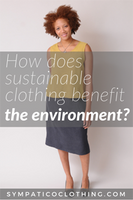How does sustainable clothing benefit the environment?
Posted by Rose on 17th Feb 2022
Focusing on sustainable clothing brands when shopping is good for the planet and its people.
The term “sustainable” crops up everywhere these days, and a lot of it looks like greenwashing. So how is one to know what kind of apparel is truly sustainable versus mere marketing?
Genuinely sustainable clothing is made with an eye on several bottom lines — not just the money one. Sustainable clothing designs must work for everyone: the earth, the workers who make it, and of course, the consumers who wear it. But what is it that makes clothing truly sustainable?
Nikki’s Swallowtail Top and Cropped Pants are sustainably made in the US in Sympatico's unique blend of hemp and Tencel.
Where the earth’s concerned, sustainable fashion requires closed-loop systems that protect the environment. Sustainable clothing is made from materials such as hemp, linen, flax and wool as well as sustainably made fibers such as Tencel that are raised, harvested and processed with minimal environmental impact.
Sustainable clothes are the polar-opposite of fast fashion, in which the primary calculations are financial. Most fast fashion is made using synthetic materials produced from petrochemicals as well conventionally grown cotton that requires immense amounts of water and pesticides.
In contrast, genuinely sustainable clothing brands offer clothes made from fabrics that minimally impact the earth and its waters. The hemp and Tencel fabric blend I use in creating the Sympatico collection is a great case in point. The 55% hemp content is grown using no pesticides or synthetic fertilizers. Unlike cotton that tends to drain the soil’s fertility, hemp grown for fiber improves the soil through aeration produced by its roots. After harvest, the remaining biomass is often left on the fields, further improving the soil. I’ve blogged about hemp’s many benefits before, and this post is a good place to dive in if you want to know more.
The 45% Tencel content in Sympatico’s fabrics is also highly sustainable. Made from farmed eucalyptus trees and produced in a closed loop system that virtually eliminates pollution, Tencel is also a planet-friendly material you can learn more about here.
Concern for the people who raise textile crops, produce and process the fabrics, and who craft the clothing is also paramount. Sustainably made clothing depends on all workers engaged in the production chain being properly protected and fairly paid. Of course, this depends on the transparency of the manufacturer in disclosing labor conditions as well as supply chain details. We still have a long way to go in this regard due largely to the complexity of today’s global economy. Sticking with artisanally made clothing is one way to assure your clothing is exploitation-free.
For the consumer, sustainable clothing embodies great design and materials that offer years of wearability. When the garment’s life is over, it can be completely recycled thanks to wise material choices. For more about smart, sustainable clothing design, check out my blog post that separates the facts and fictions of eco-fashion.
The Tank Top and Curved Skirt have classic shapes that offer years of wearability—another hallmark of sustainability.
Share:








